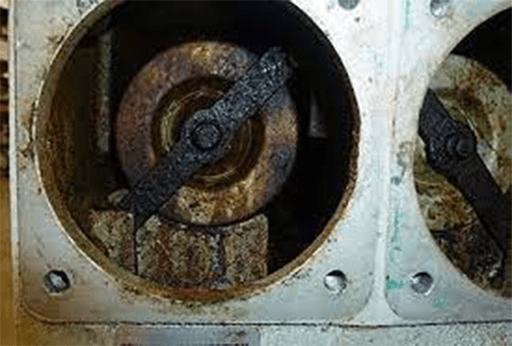
Figure 1: Vane pump.
When we use vane pumps, we often encounter some vane pump failures, but we don't know how to solve them? Let me tell you something about how to solve the vane pump failures.
1. Common Failure
Failure 1: It is difficult for the hydraulic pump to absorb oil.
Solution 1: Check and clean the oil filter, check the viscosity of the oil, and change the oil in time.
Failure 2: The pump cover screw is loose or the bearing is damaged
Solution 2: Check the more slippery and vulnerable parts.
Failure 3: There are scars on the stator surface, and the runout and impact noise occurs when the blade contacts it.
Solution 3: The stator surface needs to be trimmed and polished.

Figure 2: There are scars on the stator surface.
Failure 4: The oil level of the oil tank is too low, the oil suction side of the hydraulic pump, the oil suction pipe section and the oil seal of the main shaft of the hydraulic pump are poor, and there is air entering.
Solution 4: Check whether there is leakage at the relevant sealing parts and seal them tightly to ensure sufficient oil and smooth oil absorption.
Failure 5: The motor speed is too high.
Solution 5: Replace the motor and reduce the speed.
Failure 6: The concentricity of the coupling is poor or the installation is not firm, resulting in mechanical noise.
Solution 6: Check and adjust the concentricity and strengthen the fastening.
2. Causes and Solutions of Vane Pump not Sucking Oil or No Pressure
Cause 1: The motor turns incorrectly.
Solution 1: Reconnect the connector and change the direction of rotation.

Figure 3: Reconnect the connector and change the direction of rotation.
Cause 2: The fuel tank page is low, so it is difficult to absorb oil.
Solution 2: Check the height of the oil level in the oil tank (observe the oil indicator).
Cause 3: The oil viscosity is too large, the blade sliding resistance is large, and the movement is not flexible.
Solution 3: Replace the liquid with low viscosity.
Cause 4: There are trachomas inside the pump body, and high and low pressure collude.
Solution 4: Replace the pump body (no leakage before delivery).
Cause 5: The hydraulic pump has serious air intake and cannot absorb oil.
Solution 5: Check that there is a sealing part in the oil suction section of the hydraulic pump.
Cause 6: The screws of the assembly pump cover are loose, resulting in the interworking of high and low pressure chambers.
Solution 6: Tighten all screws.
Cause 7: The fit between blade and groove is too tight.
Solution 7: Grind blades or grooves to ensure flexible movement of blades.

Figure 4: Grind blades or grooves to ensure flexible movement of blades.
Cause 8: The rigidity of the oil distribution plate is not enough or the plate is in poor contact with the pump body.
Solution 8: Lubricate or trim its contact surface.
Related Info
What is A Vane PumpWorking Principle of a Vane Pump
Classification of Vane Pumps
How to install a Vane Pump


